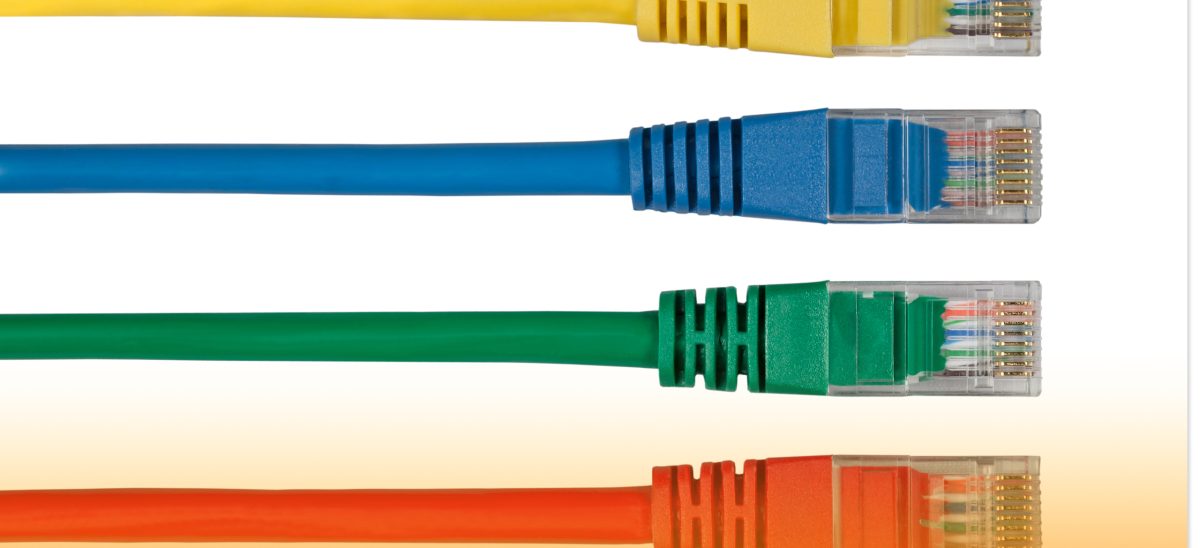Contents
- 1 RJ45 Pin Diagram
- 2 What is an RJ45 Connector?
- 3 RJ45 Connector Features and Functions
- 4 Where to Use RJ45 Connectors?
- 5 How to Connect the RJ-45 Connector?
- 5.1 Step 1: Cut the Cable to the Required Length
- 5.2 Step 2: Strip the Cable
- 5.3 Step 3: Untwist the Wires
- 5.4 Step 4: Arrange the Wires
- 5.5 Step 5: Cut the Wires
- 5.6 Step 6: Insert the Wires into the RJ45 Connector
- 5.7 Step 7: Crimp the Connector
- 5.8 Step 8: Inspect the Crimped Connector
- 5.9 What You Need to Know About Ethernet Cables
- 6 RJ45 Connector Applications
- 7 Power over Ethernet (PoE) and RJ45
- 8 Troubleshooting RJ45 Connections
- 9 Conclusion
RJ45 Pin Diagram
The RJ45 connector has a total of 8 pins that connect to eight colored wires (4 twisted pairs) in Ethernet cables. These wire pairs are responsible for transmitting power and signals in this order.
| No. | Signal name | Description | Wire color |
| 1 | TX+_D1 | Transmit data+ | White with an orange stripe |
| 2 | TX-_D1 | Transmit data- | Solid orange |
| 3 | RX+_D2 | Receive data+ | White with a green stripe |
| 4 | BI+_D3 | Bi-directional+ | Solid blue |
| 5 | BI-_D3 | Bi-directional- | White with a blue stripe |
| 6 | RX-_D2 | Receive data- | Solid green |
| 7 | BI+_D4 | Bi-directional+ | White with a brown stripe |
| 8 | BI-_D4 | Bi-directional- | Solid brown |
The table above describes the TB68B wiring scheme.
To clarify, T568B and T568A are the standard wiring schemes that define the arrangement of the wires when they are crimped to the RJ45 connector.
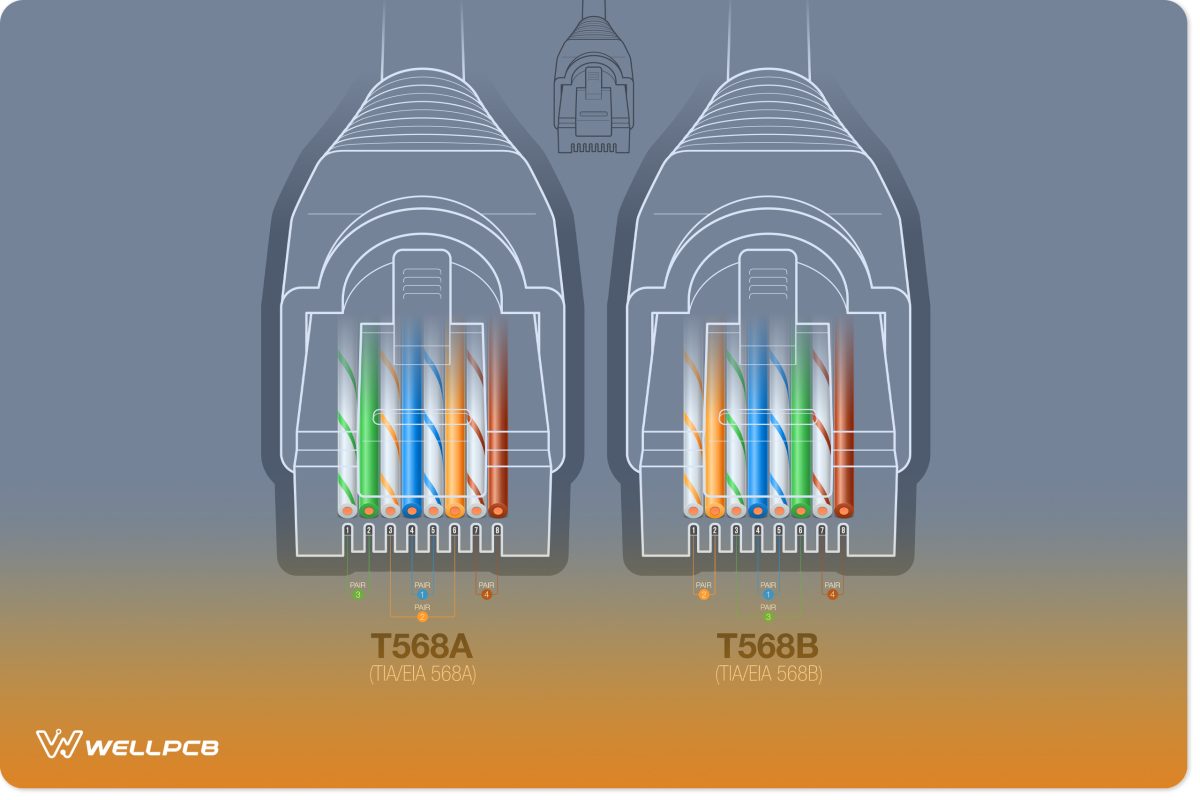
It is worth noting that the T568B standard is the most commonly used of the two because it provides better noise protection and signal isolation when interconnecting newer networking products and systems. It has the following arrangement.
- White with orange stripes
- Orange
- White with green stripes
- Blue
- White with blue stripes
- Green
- White with brown stripes
- Brown
On the other hand, T568A is designed to provide backward compatibility with older telephone wires, which is a not-so-important advantage, so most modern connections use T568B. T568A has the following arrangement.
- White with green stripe
- Green
- White with orange stripe
- Blue
- White with blue stripe
- Orange
- White with brown stripe
- Brown
Crossover vs. Straight-Through Cables
Both cables use the same Ethernet 4-twisted pair wire, but the termination in the RJ45 connector determines if the cable is a crossover or straight-through type.
The connection is straight through if you wire both ends of the cable using the same wiring scheme, which can either be T568A or T568B (but the latter is preferred). However, when both ends of the patch cable have different standard wiring schemes, the connection becomes a cross-over connection.
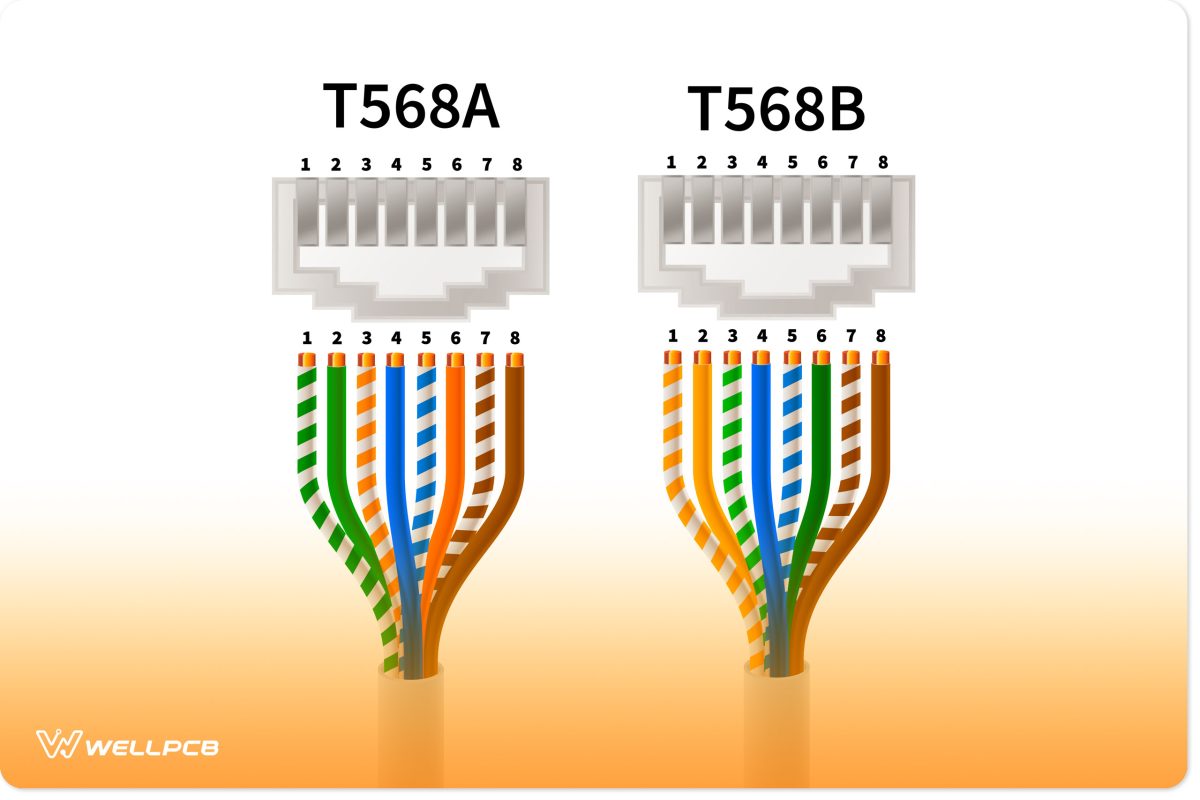
So why use crossover or straight-through cables? The former connects like or similar devices, such as computer to computer, switch to switch, or router to router. But straight-through cables link two different devices, such as computer-to-switch and computer-to-router.
What is an RJ45 Connector?
An RJ45 is a popular modular connector type that provides data communication between electronic systems.
The connector consists of metal contacts parted by plastic channels, and this plastic media should fit into the RJ45 standard jack. Its connection with the color-coded wires is made when you crimp the metal contacts, which cut through the insulation layer to contact the wire and make the joint firm. However, if pulled, the channel can detach from the jack, disrupting the electrical connection.
RJ45 ethernet connectors are similar to 8P8C (8-Position, 8-Contact) but have a key or tab that only allows you to plug in the connector in one direction and in a compatible socket. So, an RJ45 connector cannot plug into an 8P8C socket, but an 8P8C networking connector can plug into an RJ45 socket.
But not many people have come across this keyed RJ45 connector, which is the true RJ45. The networking industry commonly uses the term RJ45 to refer to the 8P8C connector, which is technically untrue. But to understand why, let’s go back in time.
History of RJ45 Connectors
RJ is an acronym for Registered Jack, a standard designation that originated with Bell System’s USOC (Universal Service Ordering Code) scheme for telephone communication interfaces in the 70s. Back then, telephone services used RJ11 connectors, which employed a 6-Position, 2-Contact (6P2C) interface.
Bell later invented RJ14 and RJ25, which use 6P4C and 6P6C respectively to provide two and three-line services, and here’s where the confusion started.
RJ technically refers to the jack’s wiring (number of positions and connected wires), but the alphanumeric currently refers to the modular connector type (number of positions) without considering the connected wires.
For instance, RJ11 only has a single twisted pair, hence its 2-contact interface. But its plug has the same number of positions (6) as the RJ14 and RJ25, despite these using two and three twisted pair wires, respectively. Therefore, all three are referred to as RJ11 because the connector is the same, which is technically inaccurate.
The same happened with RJ45. 8P8C was initially developed to handle dual trunk telephone communication lines. Bell named it RJ45 and keyed the connector. So 8P8C is more of a standard, while RJ45 is a specific keyed connector for telephone communication based on this standard.
When telephone companies began transmitting data over these connectors, the name RJ45 had already stuck. What we use today for ethernet connections don’t have keys, so they are 8P8C connectors, but they are basically the same. However, true RJ45 connectors are incompatible with the currently used RJ45 Ethernet connector ports due to the key on one side. But if you cut this tab, this networking connector will fit.
Where Does RJ45 Stand Now?
The true RJ45 networking connector is rarely used, so 8P8C is now the de-facto RJ45 Ethernet twisted-pair cabling plug because it is universally recognized and enables backward interoperability and compatibility even as Ethernet cables advance from Cat3 to Cat5e, Cat6, and higher.
RJ45 Connector Features and Functions
- Ethernet networks have indicators that display the connection status.
- Ethernet devices have receptacles or sockets that allow you to orient your device horizontally or vertically (the orientation enables you to use the gadget in distinct applications).
- Contains a tab/key that helps you avoid incorrect connection wiring.
- 8 pins for carrying lots of data or in applications that require high data speeds
- Features an external shield that prevents RFI/EMI
- Hi-Rel feature for protecting the hardware and cables
- Can have integrated magnetics to shield the system and offer current protection
- Modular connector that is almost similar to 8P8C
- Provides solderless wire and connector connections
- Easy to insert and pull out from network cards
- Affordable wiring and connectors
- Enables cable customization
- Easy to assemble/crimp and operate
RJ45 connectors can be shielded or unshielded, but the most common shielded ones are Cat6, Cat7, and Cat8 because this shielding must match the cable. This shielding is in the form of a metal case around the connector, which grounds the chassis of the interconnected devices to prevent EMI and RFI from reaching the twisted wires inside. Some even have integrated magnetics to provide current protection and better shielding.
As Ethernet advances, RJ45 modular jacks are becoming increasingly important in the computing world because the connectors (and matching CAT cables) can handle fast speeds and stable connections with zero interference if shielded. This makes them suitable for high-traffic environments, such as data centers, with the only other superior alternative being fiber. But fiber optic cables are costlier.
And when you consider the speeds offered by the latest Ethernet cables and connectors (Cat8), transmitting at speeds of up to 40Gbps is sufficient for such installations and still cheaper than fiber.
Where to Use RJ45 Connectors?
The RJ45 8-pin jack is primarily used in long-distance communication or ethernet connections as straight-through cables. With RJ45 connectors, you can send data from two different microcontrollers over a long distance without interruption. Also, there are many types of RJ45 connectors, including the original RJ45s. Devices in the Registered Jack system have the same functions, but they can feature different builds and pairs of wires.
Common real-world applications include:
- Interconnecting multiple servers in data centers
- Home networking where you can link smart TVs, computers, gaming consoles, and other internet-enabled devices to the router via cable for better performance
- Interconnecting VoIP phones in businesses
- Industrial control (connecting switches, routers, or IoT gateways to computers, PLCs, actuators, I/O, or motion controllers)
- Smart home connectivity (especially gateway to WAN)
How to Connect the RJ-45 Connector?
You need at least one RJ45 connector, an ethernet cable, and a crimping tool (with a built-in wire stripper and cutter) to complete this process.
Step 1: Cut the Cable to the Required Length
Measure the required Ethernet cable length and cut it if it exceeds this, leaving only a small allowance of a few inches.
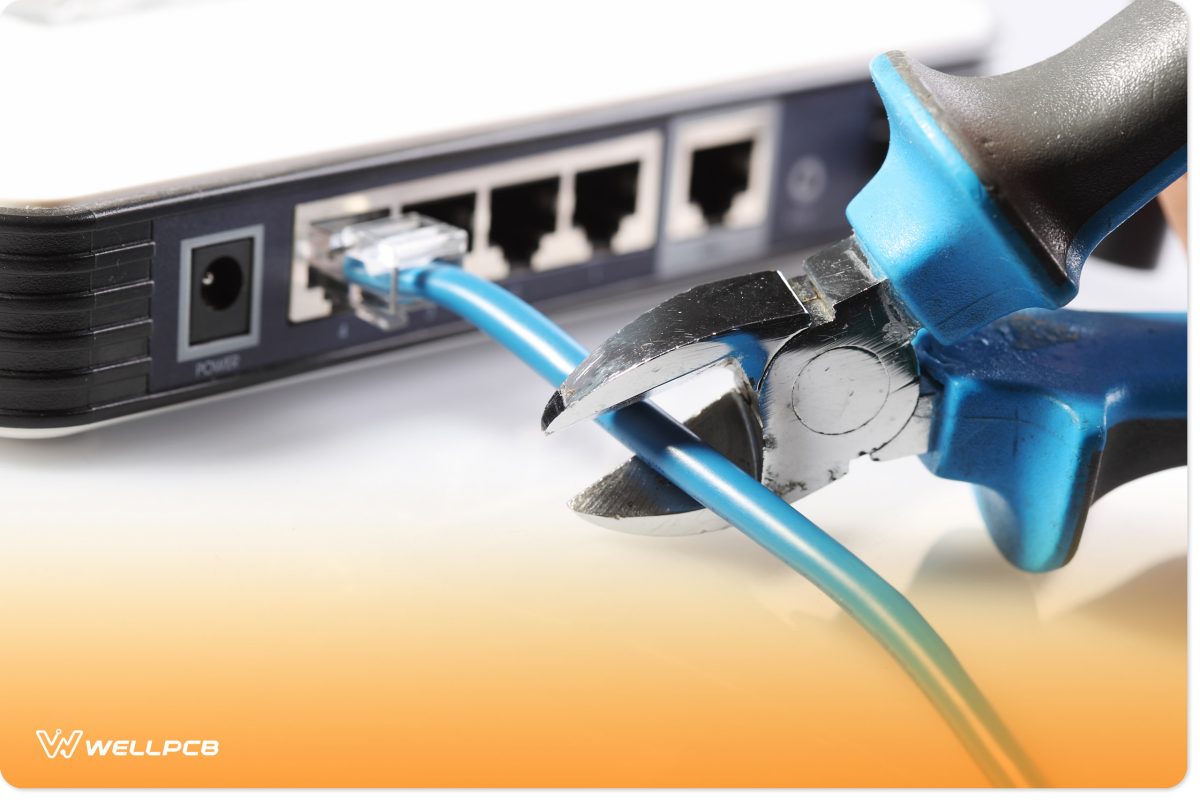
Step 2: Strip the Cable
Insert the cable into the stripping section of the crimping tool (about an inch in) and squeeze the handles tight. Rotate the tool around the cable to slice the sheath, then pull away towards the end of the wire to remove the cut sheath and reveal the 4 twisted pair wires.
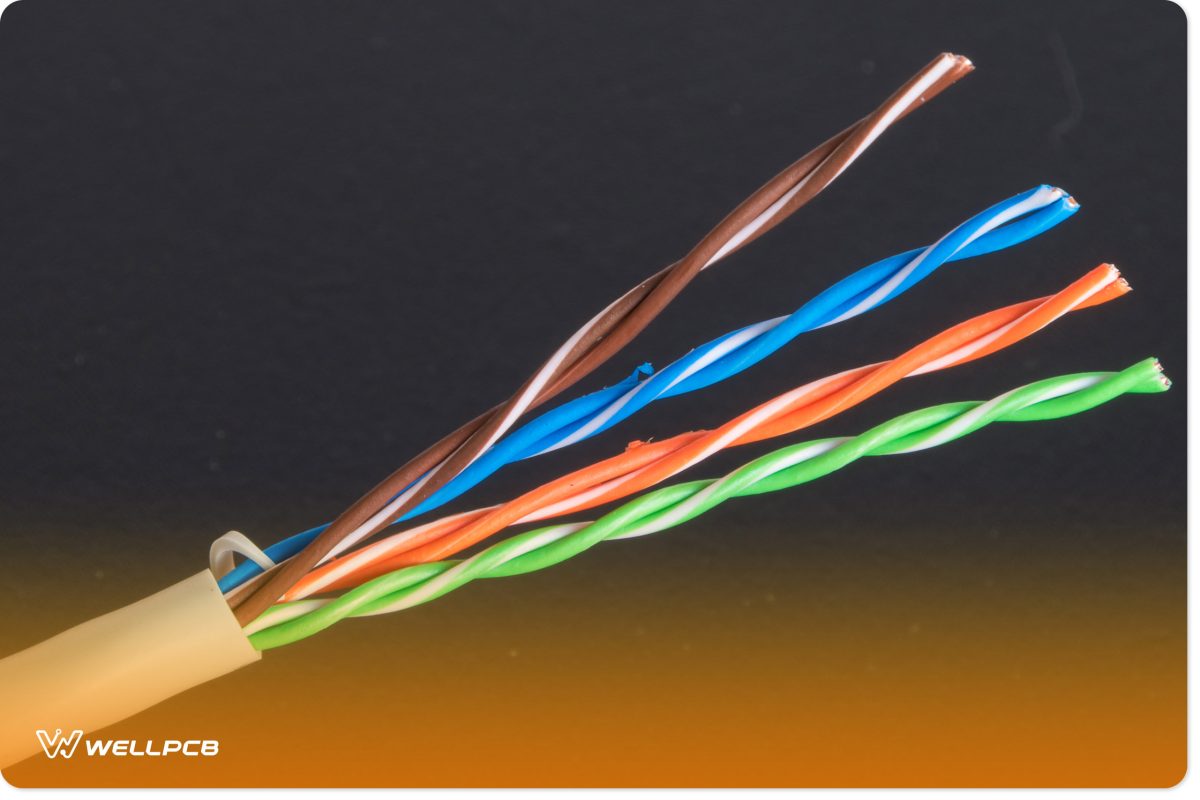
Step 3: Untwist the Wires
Untwist and straighten the 8 individual wires to prepare them for sorting. If the cable has a plastic separator inside, cut it up to where the sheath starts.
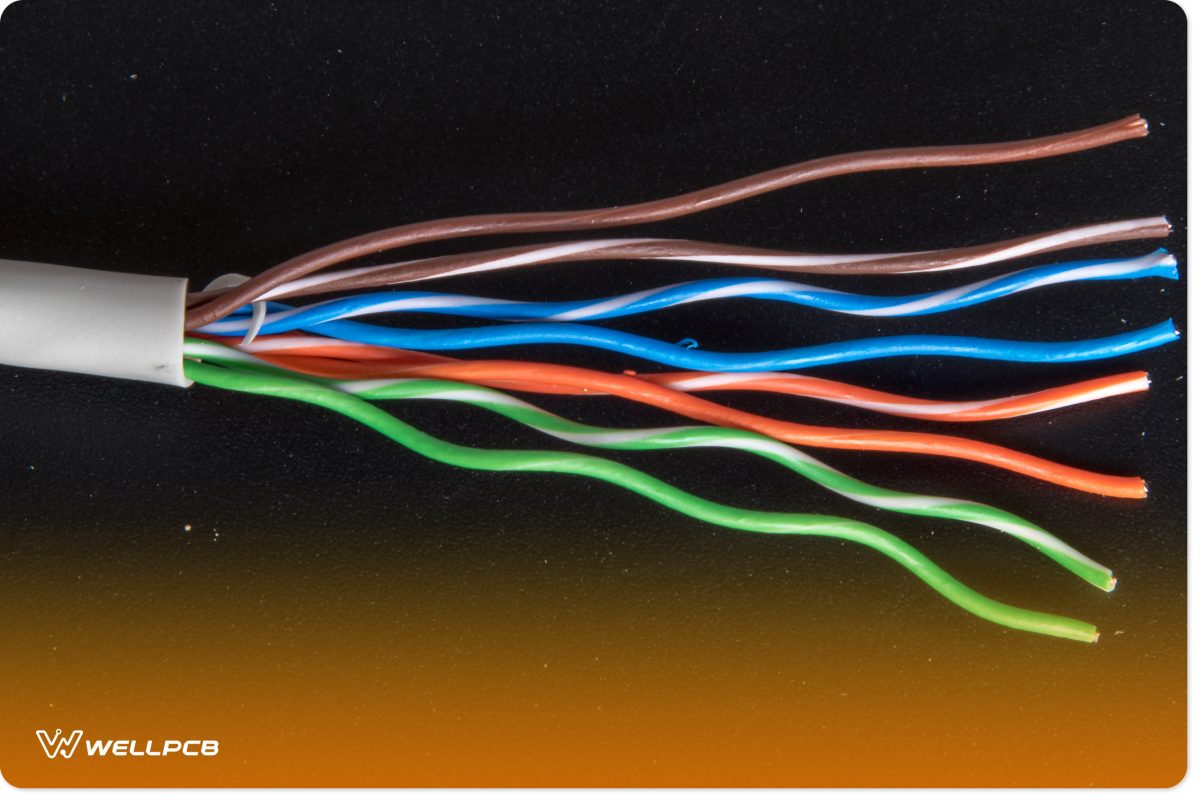
Step 4: Arrange the Wires
Arrange the wires in the required order (T568A or T568B) to form a crossover or straight-through cable.
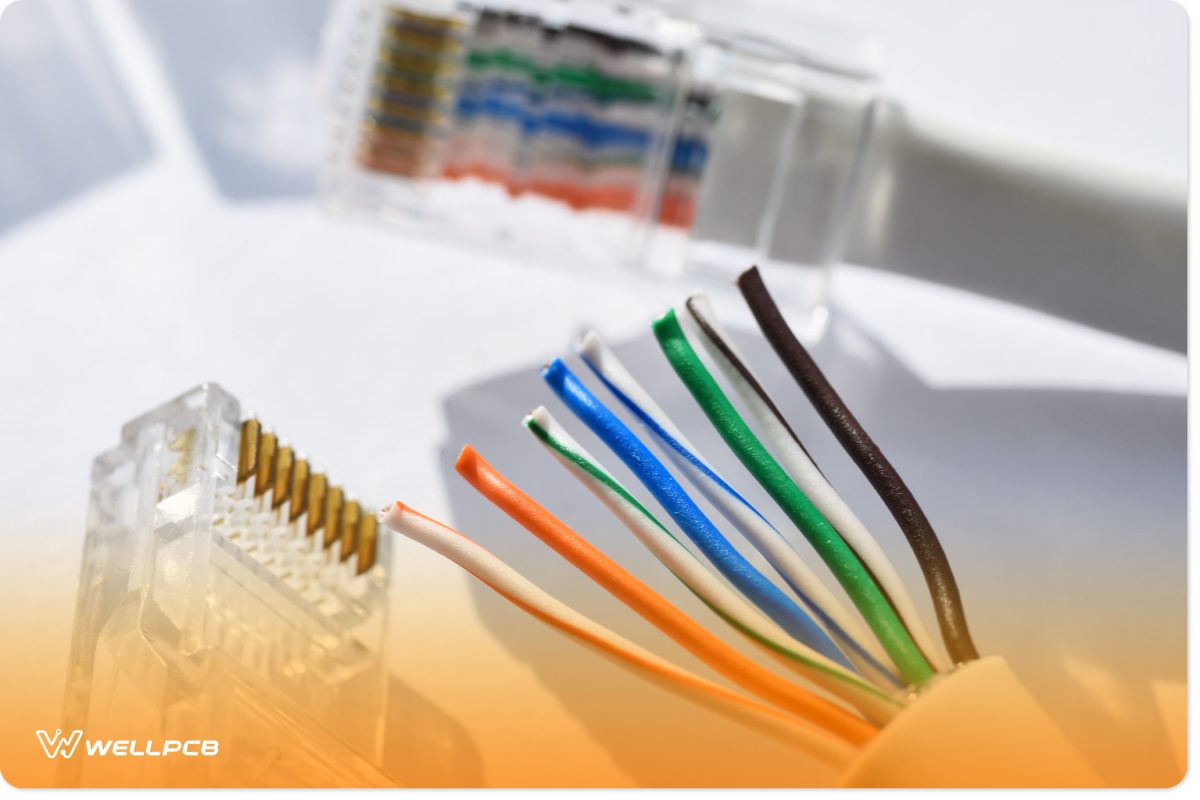
Step 5: Cut the Wires
Cut the wires to have an even length and straight line across the front, leaving about an inch from the sheath. Insert these wires into the cutting section of the crimping tool and press the handles to cut them.
Step 6: Insert the Wires into the RJ45 Connector
Hold the male RJ45 connector with the clip on the underside and the 8 tiny metal pins facing up. Next, insert the wires into the small metal grooves in the connector and push the wire gently until all 8 reach the end. Ensure you feed in about half a centimeter of the sheath into the connector as well to provide better insulation. If the wires are long enough to prevent the sheath from going in, pull them out and trim them a little.
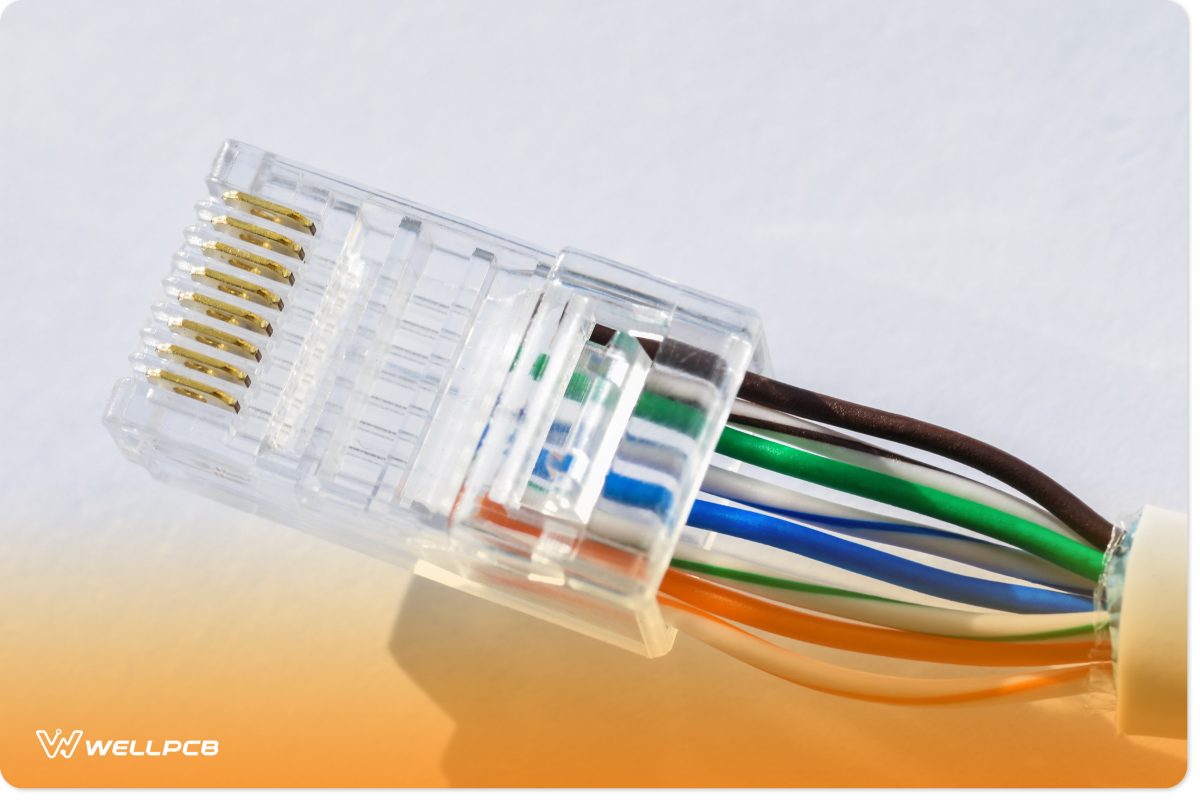
Step 7: Crimp the Connector
Insert the connector into the crimping section of the crimping tool and squeeze the handles tight. Release the handles and squeeze again to make sure all the pins have cut through the sheath and contacted the wires properly.
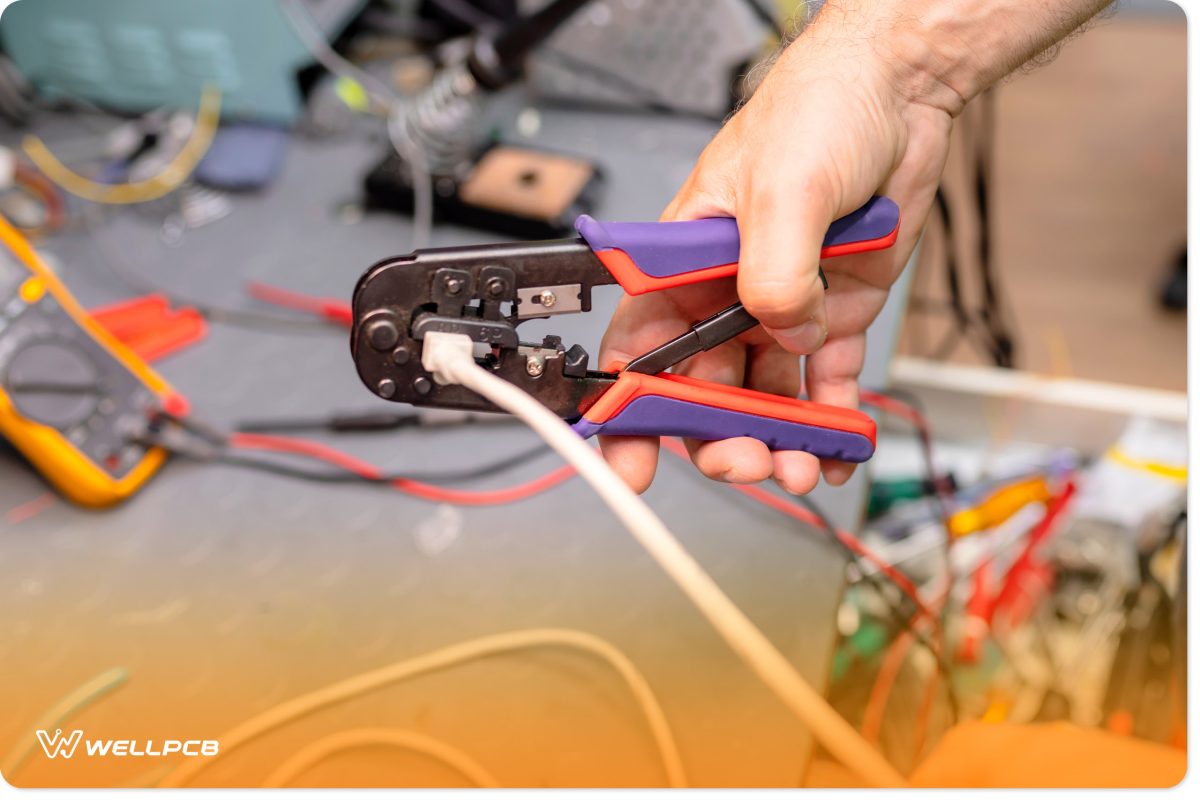
Step 8: Inspect the Crimped Connector
Remove the connector from the crimping tool and inspect it to check if all the pins are down. Try to pull the wire from the connector gently to ensure the connection is solid.
What You Need to Know About Ethernet Cables
RJ45 connectors use CAT cables as Ethernet cables, making the connector advantageous in data transmission. However, it is important to select the correct pins for data transmission and ground connection to make the protocol work efficiently.
The explanation is that the CAT cables contain twisted pairs of wires, which protect against external noise.
Since the wires are in twisted pairs, one will be the ground wire, which frees the system from interruption or external noise during long-distance communication.
But you have to pick the right CAT cable category to match your data transmission requirements. For instance, Cat5 and Cat6 Ethernet cables are the most common, and although Cat5 is 10–20% cheaper, it has lower transmission speeds, maxing out at about 100Mbps and 1000Mbps for Cat5e at distances of up to 100 meters (328 feet).
Now, this is more than enough for home use, but it is insufficient for data centers or enterprise networking.
As homes adopt smart technology, Cat5 cables might also be lacking in this application.
Cat6 Ethernet cables provide better alternatives for data centers and enterprise networks because they transmit data at speeds of up to 10Gbps for distances not exceeding 180 feet.
Another important factor to consider in large network installations like data centers is shielding.
Always use shielded Ethernet cables (usually Cat6) to prevent interference from the noisy external environment.
RJ45 Connector Applications
Rj45 connectors provide these functions.
- Ethernet cable connections
- Carrying data in noisy environments
- Supporting PoE (Power over Ethernet)
- Long-distance wired connection
The RJ45 connector for PoE is common in powering internet antennas, such as Starlink’s dish, VoIP systems in business telecommunication systems, and IP surveillance cameras. RJ45 for IoT is also becoming prevalent as homes, buildings, industries, cities, etc., become smarter and require more reliable data communication across interconnected devices. Although wireless connections are more neat, they are not as reliable as wired links.
Other Ethernet RJ45 applications include gaming, media streaming, industrial automation, and networking in the home, retail, and healthcare environments.
Power over Ethernet (PoE) and RJ45
PoE supplies direct current to electronic equipment through the unutilized twisted pairs in ethernet connectors, eliminating the need for a separate power source.
PoE has proven to be safe, flexible, scalable, and reliable. It is a better and cheaper alternative to having separate electrical cables, reduces the cost of installation fees, and provides flexibility since devices don’t have to be close to the power outlets.
You should know that the IEEE standard 802.3af operates the PoE. However, subsequent versions of this program have been developed to increase the amount of power it can distribute.
This original standard (IEEE 802.3af) can only deliver a maximum of 15.4W, which is enough to power a basic IP phone (about 5W) or standard wireless access points.
POE+ defined by IEEE 802.3at (Type 2) doubles this wattage to 30W, which can power IP cameras for security surveillance. POE++ doubles on this again, delivering a maximum of 60W, and it is defined by the standard IEEE 802.3bt (Type 3). This juice is enough to run multi-radio wireless access points, PTZ cameras, and video conferencing equipment.
The most recent PoE standard, IEEE 802.3bt (Type 4), also has the name POE++, but it can deliver up to 100W. This is enough to support most networking devices, including those used in IoT.
Troubleshooting RJ45 Connections
Some common issues that can come up when using RJ45 connectors include the following.
- Intermittent Network Failures: This issue is mostly caused by poor or improper crimping, which creates inadequate contact between the contact pins and the wires. Other causes can be incorrect wiring or termination, whereby the color coding according to T568A or T568B standards is not adhered to. Dust and debris inside the connector and damaged connectors can also cause transmission issues, which can result in a complete signal loss if the damage is extensive.
- Signal Degradation: The culprit here is a shielding issue. If installing the Cat Ethernet cables in environments with a high potential for EMI or RFI, always use shielded cables and RJ45 connectors. However, exceeding the cable length limit of 100 meters can also degrade the signal.
- Poor Performance: Mismatched cable specifications, such as using Cat5 cables in a data center, can lead to poor performance due to slow data transfer speeds. Similarly, mismatching an RJ45 can lead to below-par performance, resulting in slow loading times for apps and websites.
But by far, the most common issue has to do with crimping, and you can ensure the Ethernet RJ45 connector forms a solid joint with the wire by:
- Using a high-quality crimping tool
- Ensuring the copper wires sit flush on the end of the connector before crimping
- Double checking the wire arrangement according to T568A or T568B before crimping
- Ensuring each pin has punctured the wire sheath and contacted the copper after crimping
Conclusion
In conclusion, RJ45 connectors are not new because they were initially developed as minor improvements to telephone wiring methods in the 70s. However, their importance in Ethernet connectivity cannot be overemphasized.
Even as most wired high-speed Ethernet connections switch to fiber, RJ45 copper wire connections are still relevant because these cables and connectors transmit at reasonably high speeds for home and enterprise applications.
Need reliable RJ45 connectors for your networking needs? Explore our wide selection of high-quality RJ45 connectors at WellPCB. Contact us today for expert advice and product recommendations.
